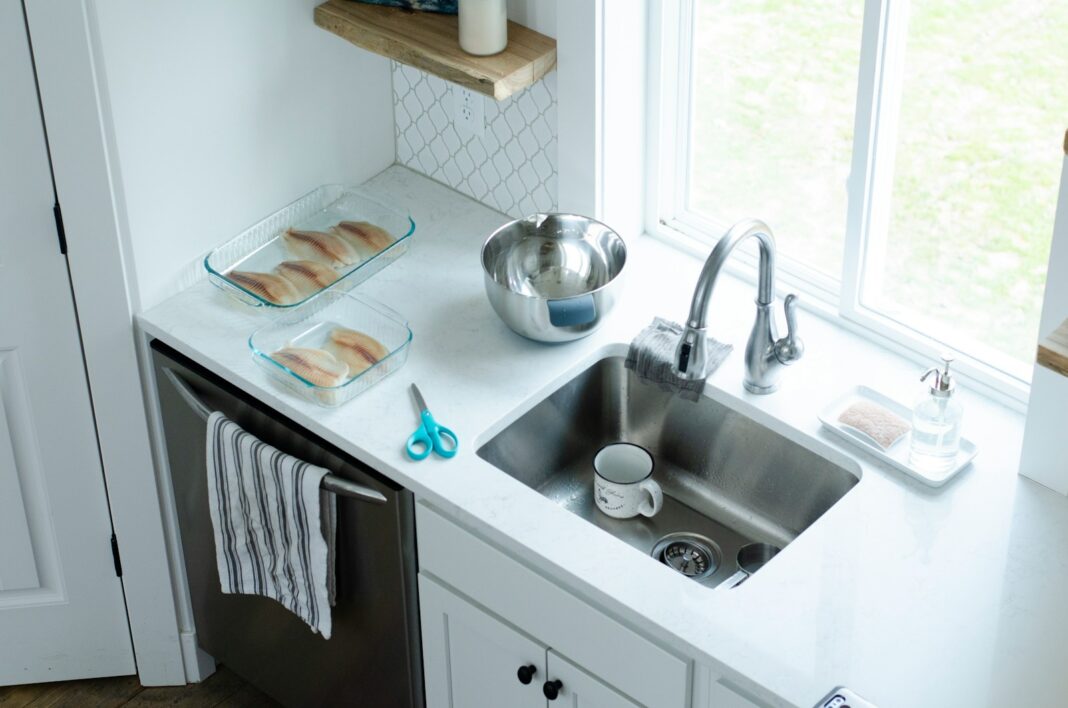Introduction
Farmhouse sinks, also known as apron-front sinks, have become a popular choice for kitchens due to their aesthetic appeal, functionality, and timeless design. These sinks are distinctive because of their deep basin and exposed front panel, giving them a rustic yet elegant charm that complements various kitchen styles. In this comprehensive guide, we will explore everything you need to know about farmhouse sinks, including their types, materials, benefits, and installation process.
Whether you’re remodeling your kitchen or designing a new one, this guide will help you make an informed decision about incorporating a farmhouse sink into your space.
What Is a Farmhouse Sink?
A farmhouse sink, also referred to as an apron-front sink, is a type of sink characterized by its large, deep basin and a front panel that juts out from the edge of the countertop. Unlike traditional undermount or drop-in sinks, farmhouse sinks extend past the cabinetry, with the front of the sink exposed. This design originated from rural homes in Europe, where such sinks were crafted to accommodate large volumes of water and dishes, making them ideal for heavy-duty kitchen use.
Key Features of Farmhouse Sinks:
- Large, deep basins for washing large pots and pans.
- Exposed front panel, which often becomes a focal point in kitchen design.
- Available in various materials and finishes to match different design aesthetics.
Types of Farmhouse Sinks
Farmhouse sinks come in several different styles, each offering unique features and benefits. Choosing the right type of sink depends on your kitchen design, budget, and personal preferences.
Single Basin Farmhouse Sink
A single basin sink is one large compartment, offering ample space for washing large items like roasting pans and baking sheets. It is perfect for homeowners who prefer simplicity and need a spacious sink to accommodate bigger kitchen tasks.
Double Basin Farmhouse Sink
A double basin farmhouse sink is divided into two compartments, which can be useful for multitasking. One side can be used for washing dishes, while the other side can be used for rinsing or drying. This type is ideal for those who like to keep tasks separate while working in the kitchen.
Flat Front vs. Curved Front Farmhouse Sink
- Flat Front: Flat front farmhouse sinks have a straight, clean line across the front panel, making them suitable for more modern or minimalist kitchen designs.
- Curved Front: These sinks have a gently rounded front, giving them a softer and more traditional appearance. Curved-front sinks often add a subtle touch of elegance to country-style kitchens.
Popular Materials for Farmhouse Sinks
The material you choose for your farmhouse sink will significantly impact its durability, maintenance requirements, and overall aesthetic. Each material offers distinct advantages, and it’s important to select one that suits your lifestyle and kitchen design.
Fireclay
Fireclay farmhouse sinks are made from molded clay that is fired at extremely high temperatures, resulting in a smooth, durable surface. These sinks are resistant to scratches, chips, and stains, making them a long-lasting option.
- Pros: Highly durable, easy to clean, heat-resistant.
- Cons: Heavier than other materials, requiring strong cabinet support.
Stainless Steel
Stainless steel sinks offer a sleek and modern look. They are lightweight, easy to maintain, and resistant to rust and corrosion. This material is commonly found in modern or industrial-style kitchens.
- Pros: Affordable, durable, and easy to clean.
- Cons: Susceptible to scratches and can become noisy when water or dishes hit the metal surface.
Cast Iron
Cast iron sinks are coated with a layer of enamel, providing a glossy, smooth finish. These sinks are incredibly sturdy and offer a vintage appeal, often found in traditional kitchen designs.
- Pros: Strong and durable, retains heat, and is resistant to stains.
- Cons: Heavy and prone to chipping over time if not properly cared for.
Copper
Copper farmhouse sinks provide a unique, rustic look that patinas over time, creating a distinctive, aged appearance. It is naturally antibacterial and offers a warm, inviting aesthetic.
- Pros: Antibacterial properties, distinctive appearance, and develops a natural patina.
- Cons: Requires regular maintenance to prevent tarnishing, can be expensive.
Granite Composite
Granite composite sinks are made from a blend of granite stone dust and resin, offering a durable, scratch-resistant surface. These sinks are available in various colors, making them versatile for different kitchen designs.
- Pros: Extremely durable, scratch and stain-resistant, available in multiple colors.
- Cons: Can be expensive and prone to cracking under heavy impact.
Benefits of Farmhouse Sinks
Farmhouse sinks offer more than just aesthetic appeal. They come with numerous functional benefits that make them a popular choice for homeowners looking to upgrade their kitchens.
Larger Basin for Greater Functionality
The deep, wide basin of a farmhouse sink provides ample space for washing large pots, pans, and baking trays. This is particularly beneficial for avid cooks or families that require a lot of dishwashing space.
Ergonomic Design
Because the sink’s front extends beyond the counter, users don’t have to lean over as much when washing dishes, making it more comfortable for daily use. The ergonomic design helps reduce back strain, especially during long periods of dishwashing.
Timeless Aesthetic
Farmhouse sinks have a classic, timeless look that can complement both traditional and modern kitchen styles. They serve as a centerpiece in the kitchen, adding a touch of charm and elegance.
Durability and Longevity
Farmhouse sinks, especially those made from fireclay, cast iron, or stainless steel, are designed to withstand heavy use. Their durability ensures that they will remain functional and beautiful for years to come.
Considerations Before Installing a Farmhouse Sink
Before committing to a farmhouse sink, there are several factors to consider to ensure it’s the right fit for your kitchen.
Cabinet Support
Farmhouse sinks are often heavier than traditional sinks, especially if you opt for materials like fireclay or cast iron. Ensure that your cabinets can support the weight of the sink. You may need to reinforce the cabinetry or build a custom base.
Size and Dimensions
Farmhouse sinks come in various sizes, so it’s essential to measure your available space accurately. Standard sizes range from 24 inches to 36 inches, but you can find custom options if needed.
Installation Type
Farmhouse sinks can be installed in three different ways:
- Undermount: The sink sits beneath the countertop, creating a seamless look.
- Flush Mount: The sink is level with the countertop, offering a smooth transition.
- Above-Counter Mount: The sink is installed above the countertop, with its edges visible.
Cost
Farmhouse sinks can be more expensive than traditional sinks due to their size and the materials used. Additionally, the cost of installation can be higher, especially if cabinetry modifications are necessary.
Installing a Farmhouse Sink: A Step-by-Step Guide
Installing a farmhouse sink requires careful planning and precise execution. Here’s a general overview of the installation process.
Step 1: Measure the Sink and Cabinet
Measure the dimensions of your farmhouse sink and ensure that your cabinetry can accommodate its size. If your current cabinetry isn’t suitable, you may need to reinforce it or consider a custom installation.
Step 2: Cut the Countertop
If your sink is replacing an existing one, the countertop will need to be modified to fit the farmhouse sink. Use the sink template to cut the correct dimensions into the countertop.
Step 3: Install the Sink Support
Farmhouse sinks are heavy, so you’ll need to install a sturdy support system within the cabinet. This could be wooden beams or metal brackets, depending on the weight of the sink.
Step 4: Set the Sink in Place
Carefully lower the sink into the countertop opening, ensuring that it fits snugly and evenly. Make any necessary adjustments to the supports or countertop if the sink doesn’t fit perfectly.
Step 5: Seal and Attach the Sink
Once the sink is properly positioned, use a sealant around the edges to prevent water from seeping into the countertop. Attach the sink to the cabinetry using brackets or screws, ensuring it’s securely fastened.
Maintenance Tips for Farmhouse Sinks
Maintaining a farmhouse sink is essential for ensuring its longevity and keeping it looking its best. Here are some tips for different types of sinks.
- For Fireclay Sinks: Clean regularly with mild soap and water. Avoid abrasive cleaners that could scratch the surface.
- For Stainless Steel Sinks: Wipe down after each use to prevent water spots and use a stainless steel cleaner to maintain shine.
- For Copper Sinks: Clean with mild soap and water, and occasionally apply a copper wax to preserve the finish.
- For Cast Iron Sinks: Clean with a non-abrasive cleaner and avoid placing heavy objects in the sink to prevent chipping.
Frequently Asked Questions
1. Are farmhouse sinks worth the investment?
Yes, farmhouse sinks are worth the investment for those who prioritize both functionality and aesthetics. Their large basin and classic design make them a valuable addition to any kitchen.
2. Do farmhouse sinks scratch easily?
This depends on the material. Stainless steel and copper sinks may be more prone to scratching, while fireclay and granite composite sinks are more scratch-resistant.
3. Can you install a farmhouse sink in existing cabinetry?
It’s possible, but you may need to modify the cabinetry to accommodate the sink’s size and weight. Reinforcing the cabinet or installing custom supports is often necessary.
4. Do farmhouse sinks require special faucets?
No, but it’s recommended to choose a faucet that complements the style and size of your farmhouse sink. High-arc or pull-down faucets often work best with these sinks.
5. Are farmhouse sinks practical for small kitchens?
Farmhouse sinks can work in small kitchens if you choose a smaller size, typically 24 to 30 inches. They can still provide ample basin space while fitting into more compact areas.
6. How do I prevent staining in my farmhouse sink?
Regular cleaning and drying after use can prevent staining, especially for materials like fireclay, cast iron, and copper. Using a sink grid can also help protect the surface.
Conclusion
Farmhouse sinks offer a blend of practicality and timeless beauty, making them a desirable feature in many kitchens. Whether you’re looking for a rustic centerpiece or a modern focal point, the variety of styles and materials available means there’s a farmhouse sink to suit every design preference. By considering the factors discussed in this guide, you can confidently choose and install a farmhouse sink that will serve as both a functional and aesthetically pleasing addition to your kitchen for years to come.















